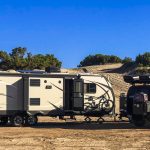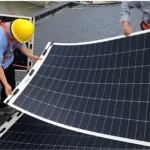Table of Contents
- How Do Solar Panels Work?
- What’s the Deal with Watts and Volts?
- How to Connect a Solar Panel to a 12 Volt Battery
- Should I Go for a 12V System or Do I Need a Higher Voltage System?
- What Are the Benefits of Using 24V Panels?
- How Do I Determine Compatibility of Components in a 12V or 24V System?
- How Do I Know What My Energy Needs Are?
- How Many Panels Would I Need to Charge a 200Ah Battery?
- Should I Choose Monocrystalline or Polycrystalline Panels?
- Portable vs. Roof Mounted Panels
- Do Panels Perform Best in Cold or Warm Climates?
- How Do I Care for Solar Panels?
- Final thoughts
Dive into the world of 12 Volt Solar Panels, a staple for off-grid living, RV enthusiasts, and remote locations. This guide provides step-by-step guidance on creating efficient and reliable 12-volt setups, whether you’re seeking power for lighting, appliances, or electronics. Say goodbye to power constraints and hello to independence.
When you think of solar panels, many envision the standard 12-volt panels mounted on roofs. And it’s easy to see why. 12-volt solar panels are versatile, safe, and powerful enough for many household and mobile applications. Given the crucial role solar panels play in any installation, it’s important to conduct thorough research. What should you consider when shopping for solar panels? Are 12V or 24V panels best, and how can you maximise their efficiency?
How Do Solar Panels Work?
Understanding how solar panels work can be very helpful when shopping for them. Photovoltaic solar panels are composed of many silicon-based solar cells. These cells have both a positive and a negative layer, creating an electric field. When sunlight hits the solar panel, it generates an electric current. This current, driven by voltage, passes through the wires and components of your system.
What’s the Deal with Watts and Volts?
When shopping for solar components, you’ll notice specifications in watts and volts. Solar installations are rated based on their energy production. As you might recall from school science classes, energy is the product of power and time.
Power (watts) is the product of voltage and current (amps). To determine how much power a system produces, you need to know both the system voltage and the output current. If two systems have the same output voltage, the one producing the most power generates the most current for a given amount of sunlight.
Higher current requires larger wiring and circuit protection components, which can be expensive. However, by doubling the voltage, you can double the power at the same current.
How to Connect a Solar Panel to a 12 Volt Battery
Connecting a solar panel to a battery is one of the most basic tasks you need to learn when getting into solar power. Wiring a solar panel to a simple 12-volt battery is one of the simplest solar power systems you can create, which is why learning this is so important.
Once you understand these basic tasks, you will be ready to start reaping the rewards of generating and using your own source of clean, renewable energy.
To help you get started, here are the basic steps to connect a solar panel to a 12-volt battery. From there, we will recommend various solar panels and kits to help you build your own solar power system.
Should I Go for a 12V System or Do I Need a Higher Voltage System?
12-volt systems are the most popular option for solar installations due to their versatility. They are suitable for many DIY solar scenarios, such as:
- RVs/motorhomes/vans
- Camper trailers
- Small cabins or tiny homes
RVs and motorhomes typically already have 12-volt batteries for lighting, hot water heater controls, AC/heating controls, and refrigerators. Therefore, it makes sense to use the voltage that is already in use in that system.
For example, Sungold’s Winner Bag Series and SPC Series portable solar panels are perfect for RVs and camper trailers, offering foldable and easy-to-carry solutions.
If your energy needs range from 1,000 to 5,000 watts, a 24-volt battery system might be more suitable.
24-volt systems are ideal for:
- Large homes and apartment buildings
- Commercial and industrial buildings
- Parking structures
For energy needs exceeding 3,000 watts, a 48-volt battery system is recommended. Large off-grid houses often use 48V systems.
What Are the Benefits of Using 24V Panels?
24-volt panels are suitable for larger installations. One key benefit of using a higher voltage system is that increasing the voltage reduces the current flowing through the system. This allows for the use of thinner cables for the same power output, significantly lowering wiring costs.
Higher voltage systems also typically offer better inverter efficiency and regulation because the inverter doesn’t have to work as hard to maintain a constant output.
Sungold’s Hi-Power Series folding solar panels, with IP68 waterproof rating and high power output, are excellent for large installations requiring efficient power conversion.
How Do I Determine Compatibility of Components in a 12V or 24V System?
If you purchase a 12V solar panel, pair it with a 12V battery (a 12V lithium battery works best with 12V solar panels), a 12V inverter, and at least a 12V charge controller. For 24V solar panels, use a 24V battery bank, a 24V inverter, and at least a 24V charge controller. Since 24V batteries are not available, you’ll need to connect two 12V batteries in series to form a 24V battery bank.
Ensure that your solar panel’s rating does not exceed that of your charge controllers. For example, if you have 12V solar panels with 14 amps, you need a charge controller rated at least 14 amps. To account for environmental factors, add 25% to this figure, making the minimum requirement 17.5 amps. In this case, you would need a 12V, 20-amp charge controller.
How Do I Know What My Energy Needs Are?
Properly sizing your solar installation is crucial. Use a solar panel calculator to input information about your lifestyle and appliance usage to determine your solar panel requirements. The calculator will provide the minimum and recommended system sizes, as well as the recommended battery output.
How Many Panels Would I Need to Charge a 200Ah Battery?
With a 200Ah battery, only 80% is usable due to depletion limitations, giving you 160 amp-hours of energy. If this lasts for two days, you use 80 amp-hours per day.
A 100-watt 12V panel produces about 30 amp-hours per day on average. To fully recharge your battery daily, you would need three 100-watt solar panels or one 300-watt 12V panel.
Should I Choose Monocrystalline or Polycrystalline Panels?
Polycrystalline panels, which are light blue, are less energy and space-efficient but cheaper. Monocrystalline panels, which are darker, are more energy-efficient. If you have high energy needs, limited roof space, or prioritise efficiency, monocrystalline panels are recommended.
For instance, Sungold’s SGM Series and SGD Series rigid solar panels offer high efficiency and are ideal for applications where performance and space are critical.
Portable vs. Roof Mounted Panels
Roof-mounted, rigid solar panels are the most common and durable. Flexible panels are suitable for non-flat roofs. Roof-mounted panels are ideal if you have consistent energy needs, want solar for your home, and prefer the convenience of charging your battery bank at the flip of a switch.
Sungold’s SGSP Series rigid solar panels and TF Series flexible panels are excellent for roof-mounted solutions, with the TF Series being particularly suitable for non-flat roofs due to its flexibility.
Portable solar panel kits are great for those not ready to install a roof system, have limited space, want to generate solar power both on the road and at home, or have smaller energy needs. Portable systems typically come as folding suitcase panels that can be set up on the ground and angled for maximum efficiency. They are lightweight and easy to handle, making them perfect for travellers.
Sungold’s Winner Bag Series and SPC Series portable solar panels are ideal for outdoor adventures, offering high efficiency and portability.
Do Panels Perform Best in Cold or Warm Climates?
Contrary to popular belief, solar panels are more efficient in colder temperatures. Excessive heat reduces their energy output. In snowy conditions, solar panels typically generate enough heat to melt snow off the panels.
How Do I Care for Solar Panels?
Solar panels require minimal maintenance. Wash them at least once a year to remove dirt and residue. In snowy areas, ensure panels do not get buried in heavy snowstorms; consider using a snow removal brush. Generally, the heat from solar panels will melt snow from lighter snowfalls. Periodically inspect the panels to ensure all connections are intact and functioning properly.
Final thoughts
Utilising 12-volt solar panels is an excellent way to become more energy independent, save on utility costs, eliminate the need for gas-powered generators, and ensure reliable access to energy when needed. As technology and efficiency continue to advance, the benefits of solar power are becoming increasingly accessible and advantageous for a wide range of applications.







